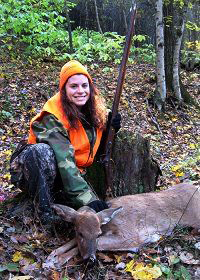By Art Lander Jr.
FRANKFORT, Ky. The first of two seasons created especially for hunters who want to take deer with muzzleloading firearms is coming up.
Kentuckys early muzzleloader deer season, which debuted in 1990, will be held this year on the weekend of Oct. 15-16.
In the past decade, the muzzleloader deer harvest has averaged 16,272 deer a year. A high of 19,918 was taken during the 2004-05 season, and a low of 13,179 bagged last season.
Because its in mid-October, our early muzzleloader season often gets impacted by hot weather, said Tina Brunjes, deer and elk program coordinator for the Kentucky Department of Fish and Wildlife Resources.
The amount of mast (acorns) available to deer is also a factor in how many deer are taken.
A bad mast year pushes deer out into the open, to forage fields and food plots, and that tends to increase the harvest, said Brunjes.

Wildlife biologists checking trees on 45 routes across the state as part of the departments annual mast survey found that 30 percent of the white oaks and 76 percent of the red oaks produced acorns this year.
The departments mast survey has been conducted annually for over 50 years. In 2007, we adopted a standardized protocol of checking marked trees, so we could share data with other states in the region, said Robinson.
Based on what we observed, this years mast crop is rated poor for white oaks (20 to 39 percent of trees produced mast), and good for red oaks (60 to 79 percent of trees produced mast), said Ben Robinson, small game biologist for Kentucky Fish and Wildlife.
Oaks, especially white oaks, are the most important tree species to wildlife in Kentucky forests. They produce acorns that are a critical food source for squirrels, white-tailed deer, wild turkey, black bear and other forest species.
Wildlife prefer white oak acorns because they are more palatable. The acorns produced by red oaks are much higher in tannin, which makes them bitter.
White oaks can produce acorns every year but entire crops are often lost due to late freezes, summer droughts or untimely rains when oak flowers are pollinating. Red oaks are more reliable year to year because it takes two years for red oak acorns to mature and not all trees produce mature acorns in the same year.
White oak stands make excellent places to set up a ground blind or tree stand.
Find a white oak that has acorns, and youve got a good place to hunt, said Brunjes. Deer will travel a considerable distance to feed on white oak acorns.
She has another suggestion for hunters. If youre trying to reduce deer numbers or improve the buck-to-doe ratio in your herd, go ahead and take a doe during the early season. Its not going to mess up your hunting for bucks during the rut, said Brunjes. You need to think of the big picture when managing deer on your hunting property.
Muzzleloaders have always been part of Kentuckys hunting history and culture. During Kentuckys muzzleloader deer seasons, hunters may use traditional muzzleloaders, such as flintlock longrifles and percussion half stock rifles, or modern in-line muzzleloaders of any caliber. Legal equipment also includes optical sights, round balls, conical bullets and saboted bullets.
Kentuckys late muzzleloader deer season is actually the older of the two seasons. It was first held in November of 1985 as a two-day hunt in 52 counties. Hunters could take only antlered deer. At that time not all 120 counties were open to deer hunting, and the state was divided into seven deer management zones.
Through the years the late season was lengthened and the bag limit liberalized. The season was eventually moved to mid-December.
By 2004, the late season had expanded from seven to nine days and opened statewide. By then, hunters could take deer of either sex in all four of the states deer management zones.
This years late muzzleloader dates are Dec. 10-18, 2011.
Media Contact: Art Lander 1-800-858-1549, ext. 4414


Be the first to comment